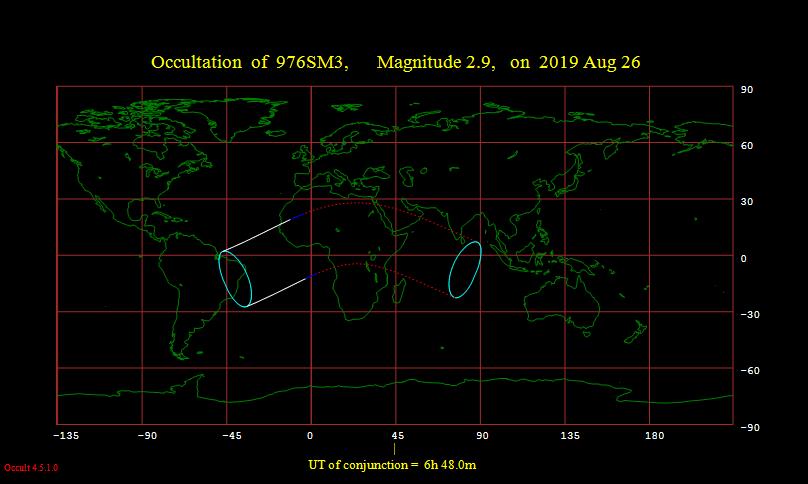
Mars, heading toward conjunction with the sun in early September, begins and ends August with conjunctions with the moon. Don’t count on seeing both. The second happens on the same day as a new moon. The red planet will simply be too close to the sun to see. Similar story for a close call with Venus on the 24th. It would be wonderful to see them just 0.3° apart. Well, I’ve long said that half the fun of astronomy is knowing what’s happening even if the weather or other circumstances keep you from seeing it. Your best bet is to spot Mars 1.7° south of a thin crescent moon on the 1st. The best views will be from around 15° south latitude where the ecliptic will be perpendicular to the horizon at sunset.

Jupiter is in the south at sunset about 7° from Antares in Scorpius. The big planet appears stationary at the start of this month. A waxing gibbous moon passes by on the 9th. In the second half of the month, careful observers should notice that the planet has resumed direct motion (going eastward). The actual start of direct motion is on the 11th. Also, while it’s easiest to describe the planet as being close to Scorpius, it’s actually within the International Astronomical Union’s boundaries of Ophiuchus.


Saturn’s retrograde motion continues in Sagittarius. The moon will be near on the 11th and 12th. There’ll be an occultation visible from many South Pacific islands including the North Island of New Zealand. The central conjunction time for the moon and Saturn is 9:53 Universal Time on the 12th.


Mercury is a morning object below Gemini when August starts. It seems to hover in place for the first week or so. After greatest elongation on the 9th at 19.0° west of the sun, it rushes sunward across Cancer for a rendezvous with the Beehive Cluster on the 17th. Leo’s head is rising in the second half of the month. Mercury is firmly in the constellation when it becomes invisible by the end of August. The best views of the messenger planet this month are from around 12° north.

Venus is too close to the sun to see this month. It’s in superior conjunction (on the other side of the sun) on the 12th and 13th. In the weeks ahead, the goddess planet will begin an evening reign.
Venus is at perihelion on the 8th. It will be 0.718 astronomical units from the sun. Mercury’s perihelion happens on the 20th at a distance of 0.307au. Mars is at aphelion on the 26th with a distance of 1.666au.

Another occultation to note is the moon covering Tejat. The central conjunction time is 6:48 UT on the 26th. The views are in the Atlantic Ocean from the Brazil Basin to the Gulf of Guinea.
The Perseid meteor shower peaks around August 12. A nearly full moon will make the fainter meteors hard or impossible to see. This is mainly a northern hemisphere shower.
A minor meteor shower, the Kappa Cygnids, peaks on August 18. You may see less than five meteors per hour coming from one of the westernmost stars in Cygnus.
Moon phases and positions this month:
New moon on the 1st. First quarter on the 7th. Full moon on the 16th. Last quarter on the 23rd. New moon on the 30th.
Perigee on the 2nd at 359,300 km center-to-center distance. Apogee on the 17th at 406,200 km. Perigee on the 30th at 357,200 km.
The moon is on the equator going south on the 5th, at southern lunistice on the 12th, goes north again on the 19th, and at northern lunistice on the 26th.
Here are some conjunctions this month. The events of the 29th and 30th are listed here for informational reasons. It will not be feasible to see Mercury, Regulus, Mars, and Venus when they are so close to the sun.
1 – An 18-hour old moon is 1.6° from Mars.
2 – moon and Regulus 3.1°
6 – moon and Spica 7.2°
8 – Mercury and Pollux 9.1°
9 – Moon and Antares 7.7°
9 – Moon and Jupiter 2.4°
12 – Moon and Saturn 0.0°, occultation
12 – Moon and Pluto 0.1°
13 – Jupiter and Antares 6.7°
13 – Venus at superior conjunction 1.3° from the sun
17 – Moon and Neptune 3.5°
18 – Mars and Regulus 0.7°
21 – Venus and Regulus 0.9°
21 – Moon and Uranus 4.4°
24 – Moon and Aldebaran 2.4°
24 – Moon and Venus 0.3°
27 – Moon and Pollux 6.0°
29 – Mercury and Regulus 1.3°
29 – Moon and Regulus 3.1°
30 – Moon and Mercury 1.9°
30 – Moon and Mars 2.9°
30 – Moon and Venus 2.8°
